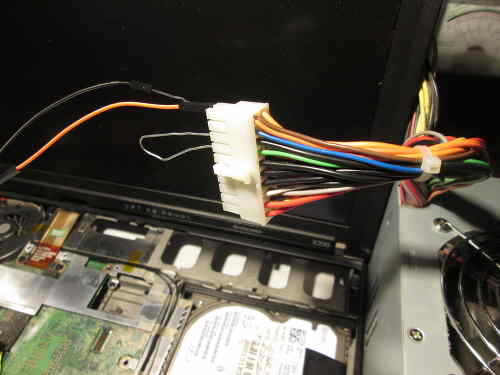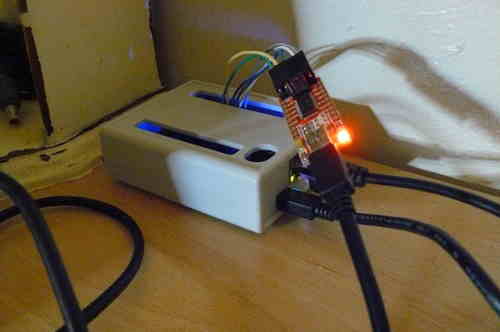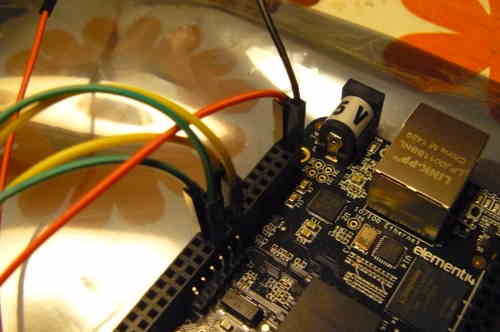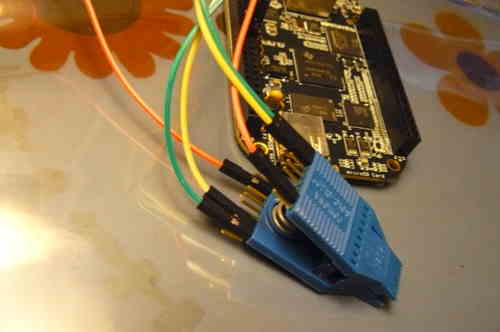How to programme an SPI flash chip with the BeagleBone Black
This document exists as a guide for reading from or writing to an SPI flash chip with the BeagleBone Black,
using the flashrom software.
BeagleBone Black rev. C was used when creating this guide, but earlier revisions
may also work.
Back to previous index
Hardware requirements
Shopping list (pictures of this hardware is shown later):
-
External SPI programmer: BeagleBone Black (rev. C)
is highly recommended. Sometimes referred to as 'BBB'.
This page contains a list of distributors.
-
Electrical tape: cover the entire bottom surface of the BBB (the part that
rests on a surface). This is important, when placing the BBB on top of a board
so that nothing shorts.
-
Clip for connecting to the flash chip: if you have a SOIC-16
flash chip (16 pins), you will need the Pomona 5252
or equivalent. For SOIC-8 flash chips (8 pins), you will
need the Pomona 5250 or equivalent. Do check which chip you have,
before ordering a clip. Also, make sure to buy at least two clips
(they break easily).
-
External 3.3V DC power supply, for powering the flash chip.
An ATX power supply / PSU (common on Intel/AMD desktop computers) will work for this.
-
External 5V DC power supply, for powering the BBB.
The BeagleBone can have power supplied via USB, but a
dedicated power supply is recommended.
-
Pin header / jumper cables (2.54mm / 0.1" headers)
You should get male-male, male-female and female-female
cables in 10cm and 20cm sizes. Just get a load of them.
-
Mini USB A-B cable (the BeagleBone probably already comes
with one.)
-
FTDI TTL cable or debug board, for accessing the serial console on your BBB.
This page contains
a list.
Back to top of page.
Setting up the 3.3V DC PSU
ATX PSU pinouts are on wikipedia
On 20-pin ATX PSUs, you can use pin 1 or 2 (orange) for 3.3V, and any of the ground/earth sources (black cables).
Short PS_ON# / Power on (green) to a ground (black. there is one right next to it) using a wire/paperclip/jumper then
power on the PSU.
On newer 24-pin ATX PSUs, there is an additional 3.3V (orange) on pin 12.
You only need one 3.3V supply and one ground for the flash chip, after grounding PS_ON# to ground.
Multiple 3.3V supplies means that you could theoretically power multiple flash chips at once with the
same PSU.
The male end of a 0.1" or 2.54mm header cable is not thick enough to remain permanently
connected to the ATX PSU on its own.
When connecting header cables to the connector on the ATX PSU, use a female end attached to
a thicker piece of wire (you could use a paper clip), or wedge the male end of the jumper cable
into the sides of the hole in the connector, instead of going through the centre.
Here is an example set up:

Accessing the operating system on the BBB
The operating system on your BBB will probably have an SSH daemon
running where the root account has no password. Use SSH to access
the operating system and set a root password. By default, the OS
on your BBB will most likely use DHCP, so it should already have an IP
address.
You will also be using the OS on your BBB for programming an SPI flash chip.
Alternatives to SSH (in case SSH fails)
You can also use a serial FTDI debug board with GNU Screen, to access the serial console.
# screen /dev/ttyUSB0 115200
Here are some example photos:


You can also connect the USB cable from the BBB to another computer and a new network interface will appear,
with its own IP address. This is directly accessible from SSH, or screen:
# screen /dev/ttyACM0 115200
You can also access the uboot console, using the serial method
instead of SSH.
Setting up spidev on the BBB
Log on as root on the BBB, using either SSH or a serial console as defined in
#bbb_access. Make sure that you have internet access
on your BBB.
Follow the instructions at http://elinux.org/BeagleBone_Black_Enable_SPIDEV#SPI0
up to (and excluding) the point where it tells you to modify uEnv.txt
You need to update the software on the BBB first. If you have an
element14 brand BBB (sold by Premier Farnell plc. stores like
Farnell element14, Newark element14, and Embest), you may need
to work around a bug
in the LED aging init script before you can update your
software. If you don't have a file named
/etc/init.d/led_aging.sh, you can skip this step and update your
software as described below. Otherwise, replace the contents of
this file with:
#!/bin/sh -e
### BEGIN INIT INFO
# Provides: led_aging.sh
# Required-Start: $local_fs
# Required-Stop: $local_fs
# Default-Start: 2 3 4 5
# Default-Stop: 0 1 6
# Short-Description: Start LED aging
# Description: Starts LED aging (whatever that is)
### END INIT INFO
x=$(/bin/ps -ef | /bin/grep "[l]ed_acc")
if [ ! -n "$x" -a -x /usr/bin/led_acc ]; then
/usr/bin/led_acc &
fi
Run
apt-get update and
apt-get upgrade then reboot the BBB, before continuing.
Check that the firmware exists:
# ls /lib/firmware/BB-SPI0-01-00A0.*
Output:
/lib/firmware/BB-SPI0-01-00A0.dtbo
Then:
# echo BB-SPI0-01 > /sys/devices/bone_capemgr.*/slots
# cat /sys/devices/bone_capemgr.*/slots
Output:
0: 54:PF---
1: 55:PF---
2: 56:PF---
3: 57:PF---
4: ff:P-O-L Bone-LT-eMMC-2G,00A0,Texas Instrument,BB-BONE-EMMC-2G
5: ff:P-O-L Bone-Black-HDMI,00A0,Texas Instrument,BB-BONELT-HDMI
7: ff:P-O-L Override Board Name,00A0,Override Manuf,BB-SPI0-01
Verify that the spidev device now exists:
# ls -al /dev/spid*
Output:
crw-rw---T 1 root spi 153, 0 Nov 19 21:07 /dev/spidev1.0
Now the BBB is ready to be used for flashing. Make this persist
across reboots:
In /etc/default/capemgr add CAPE=BB-SPI0-01 at the end
(or change the existing CAPE= entry to say that, if an
entry already exists.
Get flashrom from the libreboot_util release archive, or build it from libreboot_src/git if you need to.
An ARM binary (statically compiled) for flashrom exists in libreboot_util releases. Put the flashrom binary
on your BBB.
You may also need ich9gen, if you will be flashing an ICH9-M laptop (such as the X200). Get it from libreboot_util,
or build it from libreboot_src, and put the ARM binary for it on your BBB.
Finally, get the ROM image that you would like to flash and put that on your BBB.
Now test flashrom:
# ./flashrom -p linux_spi:dev=/dev/spidev1.0,spispeed=512
Output:
Calibrating delay loop... OK.
No EEPROM/flash device found.
Note: flashrom can never write if the flash chip isn't found automatically.
This means that it's working (the clip isn't connected to any flash chip,
so the error is fine).
Connecting the Pomona 5250/5252
Use this image for reference when connecting the pomona to the BBB:
http://beagleboard.org/Support/bone101#headers
(D0 = MISO or connects to MISO).
The following shows how to connect clip to the BBB (on the P9 header), for SOIC-16 (clip: Pomona 5252):
NC - - 21
1 - - 17
NC - - NC
NC - - NC
NC - - NC
NC - - NC
18 - - 3.3V PSU RED
22 - - NC - this is pin 1 on the flash chip
This is how you will connect. Numbers refer to pin numbers on the BBB, on the plugs near the DC jack.
The following shows how to connect clip to the BBB (on the P9 header), for SOIC-8 (clip: Pomona 5250):
18 - - 1
22 - - NC
NC - - 21
3.3V PSU RED - - 17 - this is pin 1 on the flash chip
This is how you will connect. Numbers refer to pin numbers on the BBB, on the plugs near the DC jack.
NC = no connection
DO NOT connect 3.3V PSU RED yet. ONLY connect this once the pomona is connected to the flash chip.
You also need to connect the BLACK wire from the 3.3V PSU to pin 2 on the BBB (P9 header). It is safe to install this now
(that is, before you connect the pomona to the flash chip).
if you need to extend the 3.3v psu leads, just use the same colour M-F leads, but keep all other
leads short (10cm or less)
You should now have something that looks like this:


Back to top of page.
EHCI debugging
Some libreboot systems lack serial ports, so you have to use the debug port (USB) instead.
The BeagleBone can be configured for this. It may involve compiling a patched kernel.
Work is in progress to implement this, and document it in libreboot. These are just some preliminary notes.
www.coreboot.org/EHCI_Debug_Port
www.coreboot.org/EHCI_Gadget_Debug
from #coreboot
<tty0_> stefanct, 1) plug the the BBB to a running system first and make sure you see it as "Netchip" (with lsusb). if that is correct (i.e you have BBB > ver1 ) , you have to rebuild coreboot/libreboot with Net20DB instead of BBB as debug dongle
<stefanct> tty0_: the coreboot config is clear to me... it fails to show up in lsusb already
<tty0_> on BBB, unload all the modules, then modprobe g_dbgp
<tty0_> ... and when i siad lsusb, you do that on the target system, not on BBB
Copyright © 2014, 2015 Francis Rowe <info@gluglug.org.uk>
Copyright © 2015 Patrick "P. J." McDermott <pj@pehjota.net>
This document is released under the Creative Commons Attribution-ShareAlike 4.0 International Public License and all future versions.
A copy of the license can be found at ../license.txt.
This document is distributed in the hope that it will be useful,
but WITHOUT ANY WARRANTY; without even the implied warranty of
MERCHANTABILITY or FITNESS FOR A PARTICULAR PURPOSE. See ../license.txt for more information.




